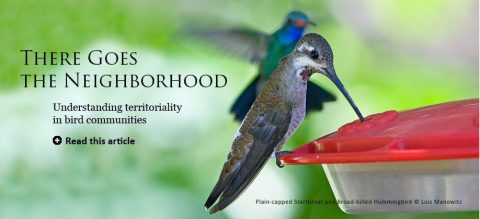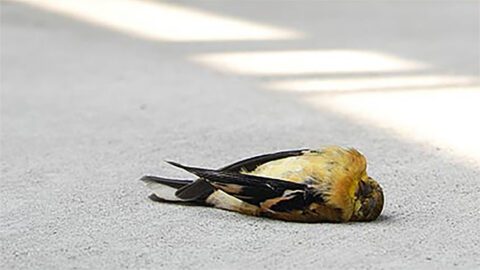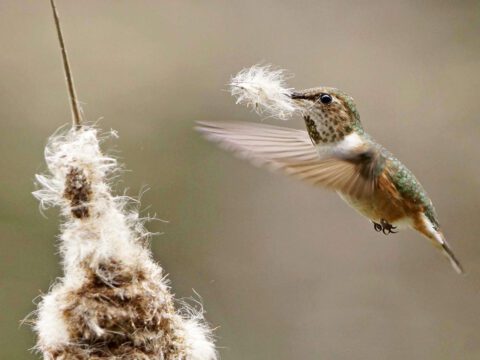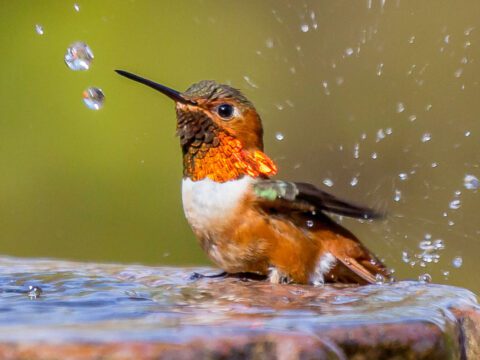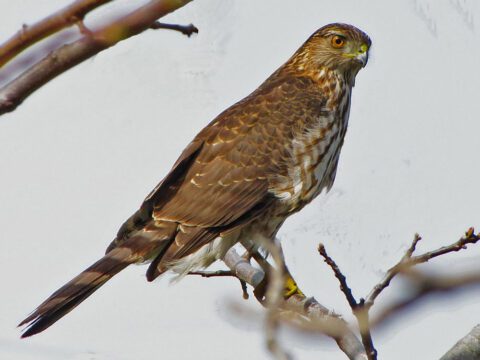There Goes the Neighborhood: Territoriality in Bird Communities
By Neil Losin
April 15, 2011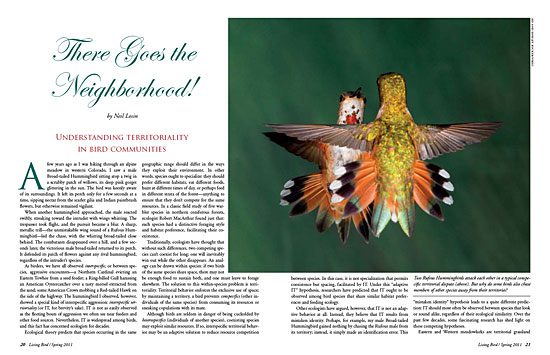
A few years ago as I was hiking through an alpine meadow in western Colorado, I saw a male Broad-tailed Hummingbird sitting atop a twig in a scrubby patch of willows, its deep pink gorget glittering in the sun. The bird was keenly aware of its surroundings. It left its perch only for a few seconds at a time, sipping nectar from the scarlet gilia and Indian paintbrush flowers, but otherwise remained vigilant.
When another hummingbird approached, the male reacted swiftly, streaking toward the intruder with wings whirring. The trespasser took flight, and the pursuit became a blur. A sharp, metallic trill—the unmistakable wing sound of a Rufous Hummingbird—led the chase, with the whirring broad-tailed close behind. The combatants disappeared over a hill, and a few seconds later, the victorious male broad-tailed returned to its perch. It defended its patch of flowers against any rival hummingbird, regardless of the intruder’s species.
As birders, we have all observed interspecific, or between species, aggressive encounters—a Northern Cardinal evicting an Eastern Towhee from a seed feeder; a Ring-billed Gull harassing an American Oystercatcher over a tasty morsel extracted from the sand; some American Crows mobbing a Red-tailed Hawk on the side of the highway. The hummingbird I observed, however, showed a special kind of interspecific aggression: interspecific territoriality (or IT, for brevity’s sake). IT is not as easily observed as the fleeting bouts of aggression we often see near feeders and other food sources. Nevertheless, IT is widespread among birds, and this fact has concerned ecologists for decades.
Ecological theory predicts that species occurring in the same geographic range should differ in the ways they exploit their environment. In other words, species ought to specialize: they should prefer different habitats, eat different foods, hunt at different times of day, or perhaps feed in different strata of the forest—anything to ensure that they don’t compete for the same resources. In a classic field study of five warbler species in northern coniferous forests, ecologist Robert MacArthur found just that: each species had a distinctive foraging style and habitat preference, facilitating their coexistence.
Traditionally, ecologists have thought that without such differences, two competing species can’t coexist for long; one will inevitably win out while the other disappears. An analogy can be drawn within species: if two birds of the same species share space, there may not be enough food to sustain both, and one must leave to forage elsewhere. The solution to this within-species problem is territoriality. Territorial behavior enforces the exclusive use of space; by maintaining a territory, a bird prevents conspecifics (other individuals of the same species) from consuming its resources or sneaking copulations with its mate.
Although birds are seldom in danger of being cuckolded by heterospecifics (individuals of another species), coexisting species may exploit similar resources. If so, interspecific territorial behavior may be an adaptive solution to reduce resource competition between species. In this case, it is not specialization that permits coexistence but spacing, facilitated by IT. Under this “adaptive IT” hypothesis, researchers have predicted that IT ought to be observed among bird species that share similar habitat preferences and feeding ecology.
Other ecologists have argued, however, that IT is not an adaptive behavior at all. Instead, they believe that IT results from mistaken identity. Perhaps, for example, my male Broad-tailed Hummingbird gained nothing by chasing the Rufous male from its territory; instead, it simply made an identification error. This “mistaken identity” hypothesis leads to a quite different prediction: IT should most often be observed between species that look or sound alike, regardless of their ecological similarity. Over the past few decades, some fascinating research has shed light on these competing hypotheses.
Eastern and Western meadowlarks are territorial grassland birds whose collective distribution covers most of North America. The two species are so similar in color, size, and shape that identifying them in the field by sight alone is nearly impossible. Where their ranges overlap, birders must use the distinctive calls and songs of each species to make a positive identification. Surely the Eastern and Western meadowlarks must rank high on a list of candidates for IT caused by “mistaken identity.”
Not surprisingly, meadowlarks are indeed interspecifically territorial. Although each species prefers a slightly different habitat—higher, drier grasslands for the Western and lower, moister grasslands for the Eastern—their ecological separation is far from complete. The two species are found together at many locations in the central Great Plains, and where this occurs, males treat their heterospecific neighbors just like conspecific rivals.
Then is IT in meadowlarks a case of maladaptive mistaken identity? Probably not, despite the two species’ striking visual resemblance. For one thing, meadowlarks probably benefit from excluding heterospecifics from their territories. Available evidence suggests that the two species’ diets, nest site preferences, and breeding seasons are virtually indistinguishable. If heterospecific individuals occupied overlapping territories, they would surely compete for common resources.
In addition, although the two species look similar, their songs are quite distinctive; male meadowlarks could use vocal cues to identify their rivals. If IT were simply a result of mistaken identity, one might predict that males would respond to heterospecific song just as intensely in areas where one species occurs alone as in areas where both species occur together.
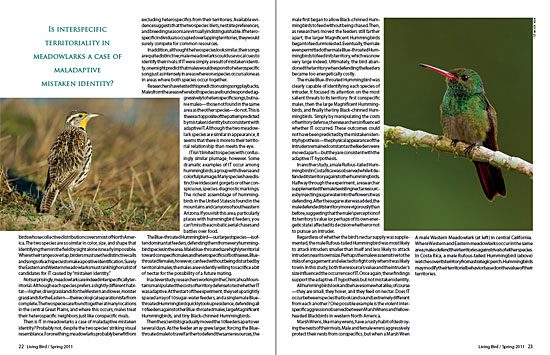
Researchers have tested this prediction using song playbacks. Males from the areas where both species are found responded aggressively to heterospecific songs, but naive males—those not found in the same area as the other species—do not. This is the exact opposite of the pattern predicted by mistaken identity but consistent with adaptive IT. Although the two meadowlark species are similar in appearance, it seems that there is more to their territorial relationship than meets the eye.
IT isn’t limited to species with confusingly similar plumage, however. Some dramatic examples of IT occur among hummingbirds, a group with diverse and colorful plumage. Many species have distinctive iridescent gorgets or other conspicuous, species-diagnostic markings. The richest assemblage of hummingbirds in the United States is found in the mountains and canyons of southeastern Arizona. If you visit this area, particularly places with hummingbird feeders, you can’t miss the acrobatic aerial chases and battles over food.
The Blue-throated Hummingbird—our largest species—is often dominant at feeders, defending them from every hummingbird species in the area. Male blue-throateds are highly territorial toward conspecific males and heterospecifics of both sexes. Blue-throated females, however, can feed without being disturbed by territorial males; the males are evidently willing to sacrifice a bit of nectar for the possibility of a future mating.
In a clever study, researchers working in the Chiricahua Mountains manipulated the costs of territory defense to test whether IT was adaptive. At the start of the experiment, they set up a tightly spaced array of 10 sugar-water feeders, and a single male Blue-throated Hummingbird quickly took up residence, defending all 10 feeders against other Blue-throated males, large Magnificent Hummingbirds, and tiny Black-chinned Hummingbirds.
Then the scientists gradually moved the 10 feeders apart over several days. As the feeder array grew larger, forcing the Blue-throated male to travel farther to defend the same resources, the male first began to allow Black-chinned Hummingbirds to feed without being chased. Then, as researchers moved the feeders still farther apart, the larger Magnificent Hummingbirds began to feed unmolested. Eventually, the male even permitted other male Blue-throated Hummingbirds to feed in its territory, which was now very large indeed. Ultimately, the bird abandoned the territory when defending the feeders became too energetically costly.
The male Blue-throated Hummingbird was clearly capable of identifying each species of intruder. It focused its attention on the most salient threats to its territory: first conspecific males, then the large Magnificent Hummingbirds, and finally the tiny Black-chinned Hummingbirds. Simply by manipulating the costs of territory defense, the researchers influenced whether IT occurred. These outcomes could not have been predicted by the mistaken identity hypothesis—the physical appearance of the intruders remained constant as the feeders were moved apart—but they are consistent with the adaptive IT hypothesis.
In another study, a male Rufous-tailed Hummingbird in Costa Rica was observed while it defended its territory against other hummingbirds. Halfway through the experiment, a researcher supplemented the male’s existing nectar resources by injecting sugar water into the flowers it was defending. After the sugar water was added, the male defended its territory more vigorously than before, suggesting that the male’s perception of its territory’s value (or perhaps of its own energetic state) affected its decision whether or not to pursue an intruder.
Regardless of whether the bird’s nectar supply was supplemented, the male Rufous-tailed Hummingbird was most likely to attack intruders smaller than itself and less likely to attack intruders near its own size. Perhaps the male was sensitive to the risks of engagement and elected to fight only when it was likely to win. In this study, both the resource’s value and the intruder’s size influenced the occurrence of IT. Once again, these findings support the adaptive-IT hypothesis but not mistaken identity.
All hummingbirds look and behave somewhat alike, of course —they are small, they hover, and they feed on nectar. Does IT occur between species that look (and sound) extremely different from each another? One possible example is the violent interspecific aggression observed between Marsh Wrens and Yellow-headed Blackbirds in western North America.
Marsh Wrens, like many wrens, have a nasty habit of destroying the nests of their rivals. Male and female wrens aggressively protect their nests from conspecifics, but when a Marsh Wren finds an undefended nest, the results are grisly: if there are eggs, the wren will puncture them with its sharp bill and carry them away from the nest. If the nest contains chicks, the wren may kill them with sharp pecks to the head. Neither eggs nor chicks are typically eaten, so this wanton destruction is not predation; rather, this nest-destroying behavior seems to be an adaptation for reducing competition between neighboring pairs of wrens.
This behavior is so pervasive among Marsh Wrens that they have evolved behavioral and physiological adaptations to minimize their egg losses. For example, wrens construct nests with an unusually plush lining of grasses, feathers, and other soft materials, because eggs are more difficult to break if they are resting on a soft surface. Marsh Wren eggs also have unusually thick shells for their size and can withstand nearly three times more pressure than other similar-sized songbird eggs.
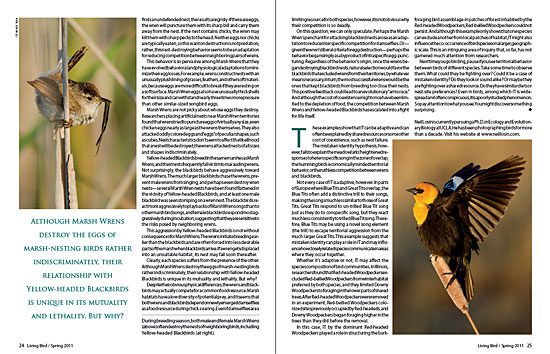
Marsh Wrens are not picky about whose eggs they destroy. Researchers placing artificial nests near Marsh Wren territories found that wrens tried to puncture eggs of virtually any size, even chicken eggs nearly as large as the wrens themselves. They also attacked oddly colored eggs and “eggs” of peculiar shapes, such as cubes. Nest characteristics don’t seem to affect the likelihood that a nest will be destroyed; the wrens attacked nests of all sizes and shapes indiscriminately.
Yellow-headed Blackbirds breed in the same marshes as Marsh Wrens, and their nests frequently fall victim to marauding wrens. Not surprisingly, the blackbirds behave aggressively toward Marsh Wrens. The much larger blackbirds chase the wrens, prevent male wrens from singing, and perhaps even destroy wren nests—several Marsh Wren nests have been found flattened in the vicinity of Yellow-headed Blackbirds, and at least one male blackbird was seen stomping on a wren nest. The blackbirds react more aggressively to playbacks of Marsh Wren songs than to other marsh bird songs, and female blackbirds respond most aggressively during incubation, suggesting that they are sensitive to the risks posed by neighboring wrens.
This aggression by Yellow-headed Blackbirds is not without consequences for Marsh Wrens. The wrens initiate breeding earlier than the blackbirds and are often forced into less desirable parts of the marsh when blackbirds arrive. If a wren gets displaced into an unsuitable habitat, its nest may fail soon thereafter.
Clearly, each species suffers from the presence of the other. Although Marsh Wrens destroy the eggs of marsh-nesting birds rather indiscriminately, their relationship with Yellow-headed Blackbirds is unique in its mutuality and lethality. But why?
Despite their obvious physical differences, the wrens and blackbirds may actually compete for a common food resource. Marsh habitats have a low diversity of potential prey, and it seems that both wrens and blackbirds depend on newly emerged damselflies as a food resource during chick-rearing. Even if damselflies are a limiting resource for both species, however, it is not obvious why their competition is so deadly.
On this question, we can only speculate. Perhaps the Marsh Wren’s penchant for attacking blackbird nests arose as an adaptation to reduce interspecific competition for damselflies. Or—given the wren’s liberal criteria for egg destruction—perhaps the behavior began simply as a byproduct of intraspecific egg-puncturing. Regardless of the behavior’s origin, once the wrens began destroying blackbird nests, natural selection would favor the blackbirds that excluded wrens from their territories, by whatever means necessary. In turn, the most successful wrens would be the ones that kept blackbirds from breeding too close their nests. This positive feedback could lead to an evolutionary “arms race.” And although the cost of coexistence might once have been limited to the depletion of food, the competition between Marsh Wrens and Yellow-headed Blackbirds has escalated into a fight for life itself.
These examples show that IT can be adaptive and can often be explained by shared resources or some other cost of coexistence, such as nest failure. The mistaken identity hypothesis, however, fails to explain the meadowlarks’ heightened responses to heterospecific song in the zone of overlap, the hummingbirds’ economically minded territorial behavior, or the ruthless competition between wrens and blackbirds.
Not every case of IT is adaptive, however. In parts of Europe where Blue Tits and Great Tits overlap, the Blue Tits often add a distinctive trill to their songs, making the songs much less similar to those of Great Tits. Great Tits respond to un-trilled Blue Tit song just as they do to conspecific song, but they react much less consistently to trilled Blue Tit song. Therefore, Blue Tits may be using a novel song element (the trill) to escape territorial aggression from the much larger Great Tits. This example suggests that mistaken identity can play a role in IT and may influence how closely related species communicate in areas where they occur together.
Whether it’s adaptive or not, IT may affect the species composition of bird communities. In Illinois, researchers found that Red-headed Woodpeckers excluded Red-bellied Woodpeckers from winter habitat preferred by both species, and they limited Downy Woodpeckers to foraging in the lower parts of shared trees. After Red-headed Woodpeckers were removed in an experiment, Red-bellied Woodpeckers colonized sites previously occupied by Red-headeds, and Downy Woodpeckers began foraging higher in the trees than they did before the removal.
In this case, IT by the dominant Red-headed Woodpeckers played a role in structuring the bark-foraging bird assemblage: in patches of forest inhabited by the Red-headed Woodpeckers, Red-bellied Woodpeckers could not persist. And although this example only shows that one species can exclude another from local patches of habitat, IT might also influence the co-occurrence of bird species on a larger, geographic scale. This is an intriguing area of inquiry that, so far, has not garnered much attention from researchers.
Next time you go birding, pause if you see territorial behavior between birds of different species. Take some time to observe them. What could they be fighting over? Could it be a case of mistaken identity? Do they look or sound alike? Or maybe they are fighting over a shared resource. Do they have similar diets or nest-site preferences? Even in birds, among which IT is widespread and often conspicuous, it is a poorly studied phenomenon. So pay attention to what you see. You might discover something surprising.

All About Birds
is a free resource
Available for everyone,
funded by donors like you
American Kestrel by Blair Dudeck / Macaulay Library
